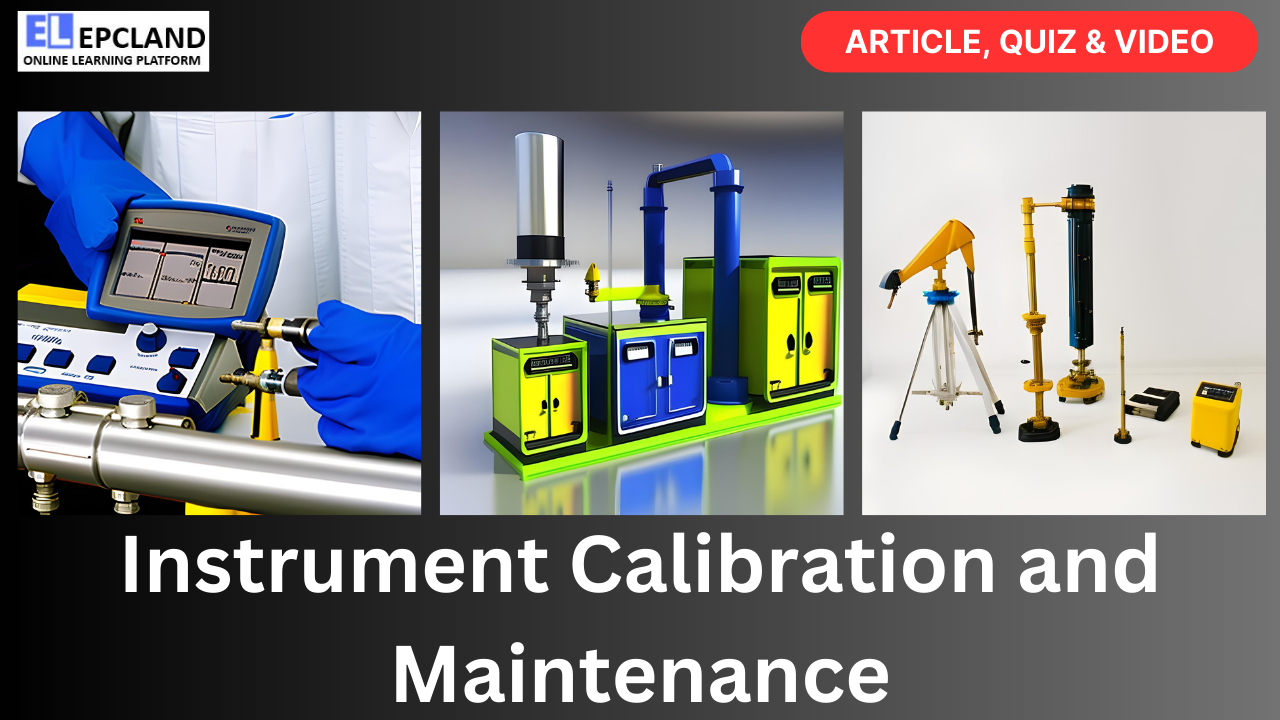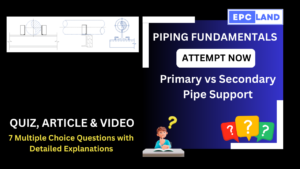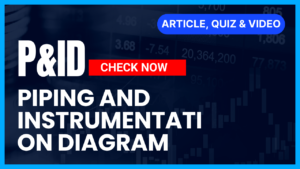Introduction
The Oil & Gas Industry relies heavily on precise measurements to ensure the safety and efficiency of its processes. Instruments used in this industry, such as pressure gauges, temperature sensors, flow meters, and level detectors, must be accurate and reliable. Calibration is the cornerstone of maintaining instrument accuracy. In this article, we will explore the fundamentals of instrument calibration in Oil & Gas Industry projects, including its importance, the calibration process, types of instruments, calibration standards, best practices, and a table of advantages and disadvantages.
Table of Contents
Do not miss the Complete Course on Piping Engineering
By EPCLand
Importance of Calibration
Instrument calibration is vital for several reasons:
Safety Assurance
Inaccurate measurements in the Oil & Gas Industry can lead to catastrophic accidents. Calibration ensures that instruments provide trustworthy data for critical safety systems.
Process Efficiency
Precise measurements are essential for optimizing production processes, reducing waste, and minimizing energy consumption.
Regulatory Compliance
Many industry regulations require instruments to be calibrated regularly to meet compliance standards.
The Calibration Process
Calibrating instruments involves a systematic process:
Selection of Reference Standards
Choose reference standards that are more accurate than the instrument being calibrated. These standards should be traceable to national or international standards.
Preparation
Clean and inspect the instrument before calibration. Ensure it is in good working condition.
Adjustment
If the instrument’s reading differs from the reference standard, make necessary adjustments to bring it into alignment.
Documentation
Document calibration results, including before and after readings, adjustments made, and calibration dates.
Traceability
Maintain a chain of traceability, ensuring that calibration standards’ accuracy can be traced back to a recognized standard.
Types of Instruments Requiring Calibration
A wide range of instruments in the Oil & Gas Industry necessitate calibration, including:
Pressure Instruments
Calibrating pressure gauges, transmitters, and relief valves is crucial for maintaining safety and operational efficiency.
Temperature Instruments
Temperature sensors, thermocouples, and RTDs (resistance temperature detectors) require calibration to ensure accurate temperature measurements.
Flow Instruments
Flow meters, including differential pressure flow meters and electromagnetic flow meters, must be calibrated for precise flow measurement.
Level Instruments
Calibrating level sensors is vital for accurate inventory management and safety in storage tanks and vessels.
Analytical Instruments
Instruments measuring gas composition, such as gas chromatographs, require regular calibration to maintain accuracy.
Do not miss the Complete Course on Piping Engineering
By EPCLand
Calibration Standards
Various standards and guidelines govern instrument calibration in the Oil & Gas Industry:
ISO Standards
ISO 17025 and ISO 9001 provide guidelines for the competence and quality management of calibration laboratories.
ASTM Standards
ASTM E74 and ASTM E165 are commonly used for calibration of load cells and thermocouples, respectively.
API Guidelines
The American Petroleum Institute (API) offers guidelines for the calibration of specific instruments used in the industry.
Best Practices for Instrument Calibration
To ensure effective instrument calibration, follow these best practices:
Regular Schedule
Adhere to a predetermined calibration schedule, considering factors such as instrument usage and environmental conditions.
Qualified Personnel
Calibration should be performed by trained and certified personnel with knowledge of industry standards.
Proper Documentation
Accurate record-keeping is crucial. Maintain detailed calibration records, including instrument identification, calibration dates, and results.
Traceability
Ensure that calibration standards have a documented and traceable chain of calibration.
Environmental Control
Calibration should be performed in a controlled environment to minimize external influences.
Post-Calibration Testing
After calibration, perform tests to ensure that the instrument performs accurately in its intended application.
Calibration Challenges in the Oil & Gas Industry
Calibrating instruments in the Oil & Gas Industry presents unique challenges:
Harsh Environments
Instruments are often exposed to extreme temperatures, pressures, and corrosive substances, which can affect calibration.
Remote Locations
Calibration in remote offshore or desert locations can be logistically challenging.
Safety Considerations
Calibrating safety-critical instruments requires special precautions to prevent accidents.
Advantages and Disadvantages of Instrument Calibration
Here is a table summarizing the advantages and disadvantages of instrument calibration:
| Advantages of Instrument Calibration | Disadvantages of Instrument Calibration |
|---|---|
| Ensures accurate and reliable measurements | Requires time and resources for calibration |
| Enhances safety in the Oil & Gas Industry | Can be logistically challenging in remote locations |
| Supports regulatory compliance | Instruments may need to be taken offline during calibration |
| Optimizes production processes | Calibration standards and equipment must be periodically recalibrated |
| Reduces energy consumption and waste | Calibration records must be maintained rigorously |
| Extends the lifespan of instruments | Calibration in harsh environments may be subject to external factors |
| Maintains product quality and consistency | Calibration of complex instruments may require specialized knowledge |
Do not miss the Complete Course on Piping Engineering
By EPCLand
Conclusion
Instrument calibration is the backbone of accuracy and safety in the Oil & Gas Industry. It ensures that measurements are reliable, processes are optimized, and regulatory requirements are met. By following best practices and adhering to industry standards, the industry can continue to operate safely and efficiently while meeting the demands of the global energy landscape.
FAQs
FAQ 1:
Q: What is instrument calibration in the context of the Oil & Gas Industry? A: Instrument calibration in the Oil & Gas Industry refers to the process of adjusting and verifying the accuracy of measurement and control instruments used in various processes. It ensures that these instruments provide reliable and accurate data, which is crucial for safety, efficiency, and compliance.
FAQ 2:
Q: Why is instrument calibration so important in the Oil & Gas Industry? A: Instrument calibration is vital in this industry for several reasons. It ensures safety by preventing accidents due to inaccurate measurements, optimizes processes for efficiency, and helps comply with regulatory standards. Accurate measurements also reduce energy consumption and waste.
FAQ 3:
Q: What types of instruments in the Oil & Gas Industry require calibration? A: Various instruments in this industry require calibration, including pressure gauges, temperature sensors, flow meters, level detectors, and analytical instruments like gas chromatographs. These instruments are critical for monitoring and controlling processes.
FAQ 4:
Q: How often should instruments be calibrated? A: The frequency of calibration depends on factors such as instrument usage, environmental conditions, and regulatory requirements. Typically, instruments are calibrated at regular intervals, ranging from quarterly to annually.
FAQ 5:
Q: What are the common standards and guidelines for instrument calibration in the Oil & Gas Industry? A: Common standards and guidelines include ISO 17025 and ISO 9001 for quality management, ASTM standards like ASTM E74 and ASTM E165, and guidelines provided by organizations like the American Petroleum Institute (API).
FAQ 6:
Q: What challenges are faced when calibrating instruments in the Oil & Gas Industry? A: Challenges include exposure to harsh environments (extreme temperatures, pressures, and corrosive substances), logistical challenges in remote locations, and ensuring safety during calibration of critical instruments.
FAQ 7:
Q: What are the advantages and disadvantages of instrument calibration? A: The advantages include ensuring accurate measurements, enhancing safety, regulatory compliance, process optimization, energy conservation, instrument lifespan extension, and maintaining product quality. Disadvantages include the time and resources required, logistical challenges in remote locations, instrument downtime during calibration, and the need for periodic recalibration.
Recommended courses (Published on EPCLand)
- Basics of Piping Engineering
- Piping Layout Engineering
- Piping Material Engineering
- Piping Stress Analysis
- Complete Course on Piping Engineering
- Material Requisitions
- Piping Material Specifications
- Valve Material Specifications
Don’t miss the published articles on following:
Do not miss the Complete Course on Piping Engineering
By EPCLand
Related Video
Attempt Quiz
Question 1:
Why is calibration important in oil & gas projects?
Explanation: Calibration in oil & gas projects is crucial to ensure safety, accuracy, and compliance with regulatory standards.
Question 2:
What is the primary purpose of instrument calibration?
Explanation: The primary purpose of instrument calibration is to adjust instruments to a standard reference for accurate measurements.
Question 3:
Which factor is crucial when calibrating instruments for oil & gas applications?
Explanation: Calibration interval is crucial when calibrating instruments for oil & gas applications to ensure ongoing accuracy.
Question 4:
What is traceability in instrument calibration?
Explanation: Traceability in instrument calibration means the ability to track the calibration process to a recognized standard, ensuring reliability and accuracy.
Question 5:
What is the purpose of calibration certificates?
Explanation: Calibration certificates are used to document calibration results and traceability, providing evidence of instrument accuracy.



